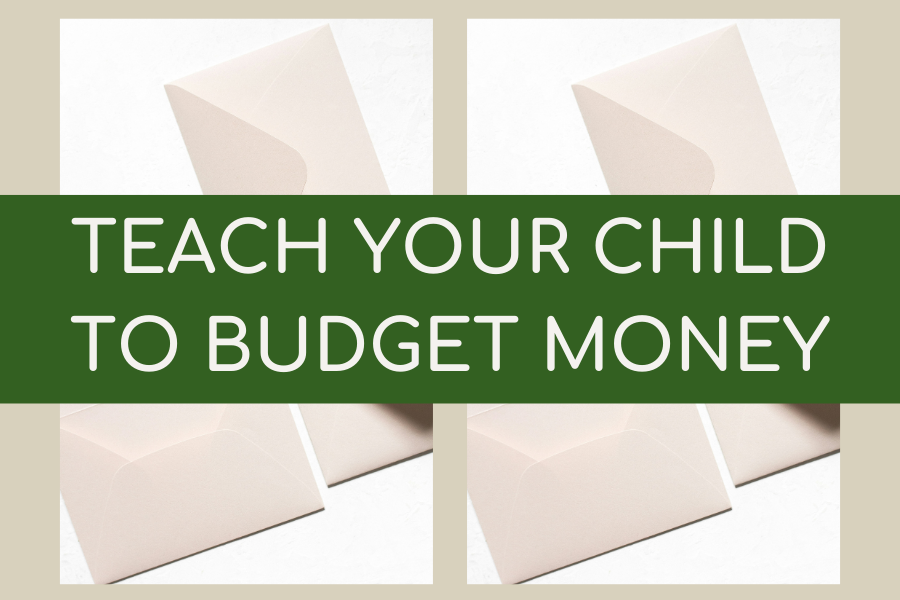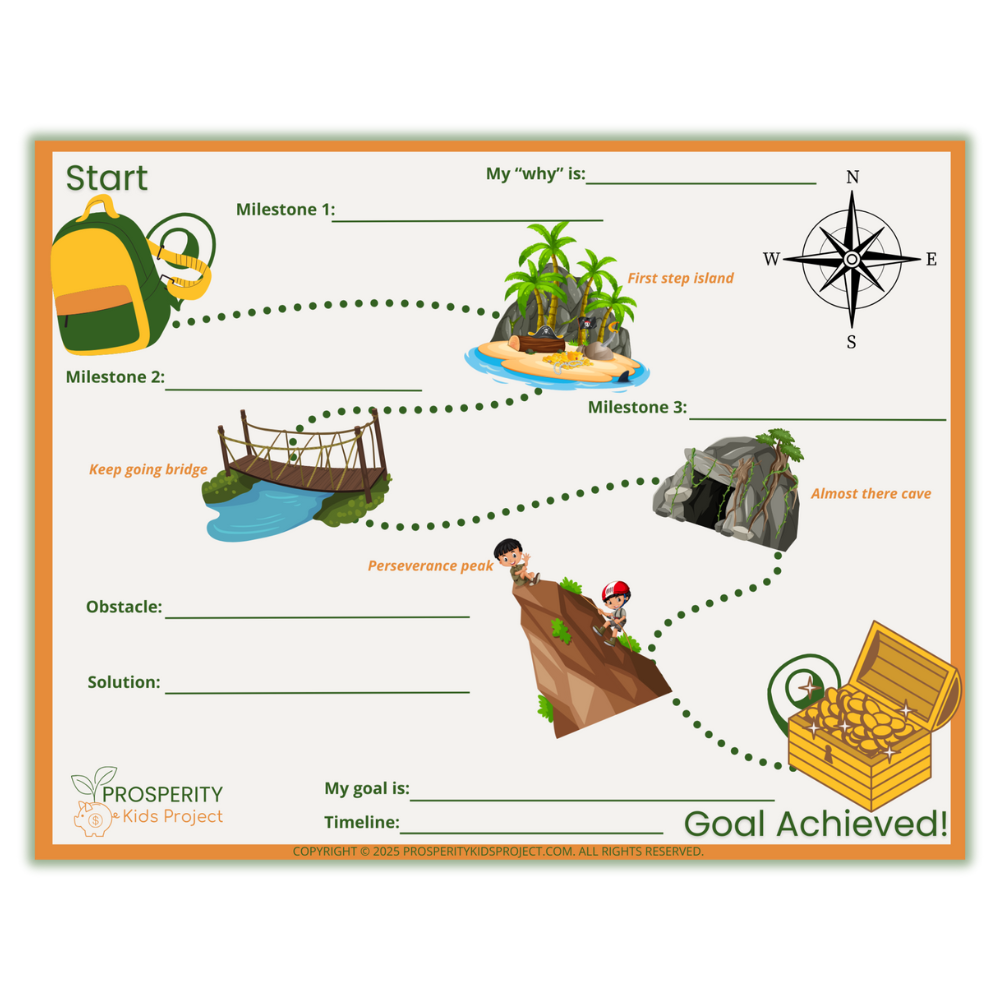Not sure how to teach your child to budget money in a way that’s easy, fun and will stick with them for life? This post will teach you 5 easy tactics you can apply today!

I was seven years old at TJMaxx, locked in an intense showdown with my mom over a sparkly new shirt I desperately needed. The persistence I had? Like a mule. A very loud, very determined, no-concept-of-money, sparkly-shirt-obsessed mule. But instead of giving in just to shut me up, she stood her ground: “If you want it that bad, you have to save up for it.” Devastating. Unfair. The worst thing I’d ever heard.
Now? Best lesson she ever taught me.
Sound familiar? Kids want things now, and as parents, we want to teach them patience and smart money habits—but let’s be honest, budgeting can feel about as exciting as watching paint dry. The good news? It doesn’t have to be! Teaching kids how to manage money can actually be simple, fun, and confidence-boosting (for both of you).
In this post, I’ll walk you through five game-changing ways to teach your child to budget—without the eye rolls or heavy sighs. From delayed gratification to setting goals and making smart spending choices, these lessons will stick with them for life. Each one builds on the next, so be sure to read them all for the biggest impact on your child’s financial future!
5 Easy Tactics to Teach Your Child to Budget Money Like a Pro
1. Delayed Gratification: The First Step to Budgeting
Kids naturally want things now—it’s just how they’re wired. But helping them shift their mindset toward patience can set them up for lifelong financial success.
Proverbs 21:5 reminds us: “The plans of the diligent lead to profit as surely as haste leads to poverty.” Rushing into impulse decisions often leads to regret and it’s far better for kids to learn this lesson at home than in the real world.
For example, the famous Marshmallow Experiment proves this point. Young children were given a choice: one marshmallow now or two if they waited. Read more about the details of this experiment here.
Decades later, they found that those who were willing to delay gratification early in life had “lower levels of substance abuse, lower likelihood of obesity, better responses to stress, better social skills as reported by their parents.” (Clear, James. “40 Years of Stanford Research Found That People With This One Quality Are More Likely to Succeed.” Behavioral Psychology, Willpower. March 14, 2025.)
Some may argue that certain people are born with a natural ability to delay gratification, but a follow-up study showed that kids raised in stable, reliable environments were more likely to wait for the bigger reward. Read details here.
Try This Tactic:
1️⃣ Make a Promise – Choose a small reward (like a sketchbook, soccer ball, or family movie night) and tell your child they’ll earn it by waiting patiently.
2️⃣ Hold Them Accountable – If they successfully wait or show discipline, acknowledge their effort and remind them why it matters.
3️⃣ Follow Through – Always deliver on your promise to reinforce that patience pays off. This builds trust and helps them develop the discipline needed for budgeting, earning, and saving.
Author of Atomic Habits, James Clear said it best in his article above: “Success usually comes down to choosing the pain of discipline over the ease of distraction.”
Once kids understand patience, they’re ready for the next step—earning their own money.
2. Allowance with Purpose: Teaching Kids to Earn & Save
I loved earning an allowance. Contributing to my household and getting rewarded for it made me feel valued. Looking back, I think it was one of the best hands-on ways my parents taught me about money.
When kids earn their own money instead of just receiving it, they appreciate it more. They start to connect effort with reward. I actually just wrote a whole article on teaching kids the value of money—you can check it out here.
More importantly, earning is what motivates kids to save. When money is simply handed to them, they don’t experience the effort behind it—so why would they care about keeping it?
Try This Tactic:
1️⃣ Set Up an Allowance System – Assign a monetary reward for completing tasks and deduct from it when tasks aren’t done.
2️⃣ Let Them Do the Math – Have your child calculate how much they’ve earned each week. This builds responsibility and basic money math skills.
3️⃣ Pay Them on Fridays – Make payday a routine so they associate work with rewards. If you want an easy way to track this, I created an Allowance Chore Chart—grab it here!
Once kids start earning, they need to learn how to make a plan for their money—this leads naturally into setting goals.
3. Goal Setting: A Fun Way to Teach Smart Money Habits
Financial goals give kids a reason to save instead of spending impulsively. They also reinforce long-term thinking, just like they learned with delayed gratification.
When I was 12, I really wanted a phone. All my friends had one, but my parents refused to just hand it to me. They knew an easy “yes” wouldn’t serve me in the long run. Instead, they told me I could have one—if I figured out how to buy it and pay for the plan.
So, I did. I got creative, took on extra chores, and negotiated my pay. I offered to wash my relatives’ cars etc. Eventually, I saved enough for a flip phone (even though iPhones were all the rage). But that wasn’t the end. My prepaid plan gave me 120MB of data for calls and texts. When it ran out, I had to go to the store and buy another prepaid card.
That experience taught me more than just saving—it taught me problem-solving, patience, and independence. If my parents had just given me the phone, I never would have learned those lessons.
Parents, resist the urge to say “yes” just to stop the nagging. Giving in now makes life harder for them later.
Try This Tactic:
1️⃣ Ask & Identify – Talk to your child about what they want to save for. Help them choose a specific goal.
2️⃣ Plan It Out – Discuss why they want it, break it into small steps, how they’ll earn the money, and what challenges they might face as well as solutions.
3️⃣ Make It Official – Write it down! If you need a simple way to guide them, grab my free goal-setting template below! (Best for kids ages 5-12)

Once kids have goals, they need a system to manage their money—enter budgeting!
4. Kid-Friendly Budgeting: The Envelope System
Budgeting teaches kids to balance spending, saving, investing, and giving. Teaching your kids how to allocate their money now will put them miles ahead of their peers.
The easiest way to make budgeting tangible is by using envelopes. My parents did this with me, and it worked. Every time I got my allowance, they handed it to me in cash. Then, I divided it into four envelopes: spending, saving, investing, and giving.
Here’s the best part—they didn’t tell me how to split it. They didn’t need to. By this point, they had already:
✔️ Taught me delayed gratification.
✔️ Enabled me earn my own money with allowance.
✔️ Helped me set goals.
✔️ Given me a simple system (the envelopes) to manage it all.
Try this tactic:
1️⃣ Give your kids four blank envelopes and let them decorate them.
2️⃣ Have them label each one: Spending, Saving, Investing, Giving.
3️⃣ Every payday (Friday), help them divide their money between the envelopes.
Watch their confidence with money grow! When kids manage their own money, budgeting isn’t boring—it becomes a game. They’ll love seeing how much they can save while still spending on what they want.
And that brings us to the next step: spending wisely.
5. Smart Spending: Helping Kids Make Wise Money Choices
Just because kids have money to spend doesn’t mean they know how to spend wisely! Learning to compare prices, wait for sales, and evaluate needs vs. wants helps them make smart financial choices.
Although, I’ll admit—I didn’t learn this lesson until I started dating my boyfriend a few years ago. He showed me that price tags aren’t everything. Instead of grabbing the first thing with a pretty label, I needed to compare prices, check the cost per unit, and look for bulk deals when possible.
Try this tactic:
1️⃣ Pick a Purchase – Next time your child wants to buy something, take them shopping and have them choose three different options for that item.
2️⃣ Compare & Decide – Show them how to compare price per unit, look for sales or bulk discounts, and consider quality vs. cost.
3️⃣ Reflect – After they buy, talk about whether they made the best choice and how they can apply this thinking in the future.
At the end of the day, your kids can budget all they want, but if they don’t know how to be a smart spender, then they can fall into the trap of buying useless things with their spending money that they’ll later regret.
The Power of Hands-On Money Lessons
Teaching kids about money doesn’t have to be complicated. By starting small with hands-on money lessons, you’re giving them skills that will shape their future in a big way:
✔ Delayed Gratification – Patience now means smarter choices later.
✔ Earning with an Allowance – When kids work for their money, they respect it more.
✔ Setting Goals – A clear goal makes saving exciting and rewarding.
✔ Budgeting – Knowing where their money goes gives them control and builds confidence.
✔ Smart Spending – Making wise purchases allows them to be thoughtful stewards of money.
You don’t have to be a financial expert—just start the conversation, take small steps, and watch their confidence grow. The habits you help them build today will set them up for a lifetime of financial success!


